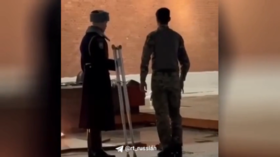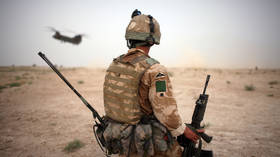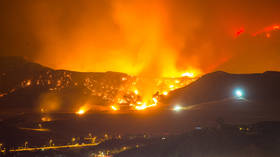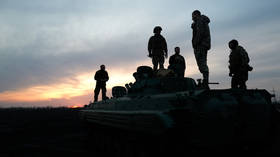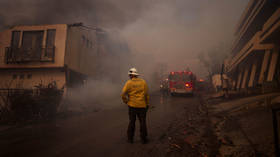Ethnic clashes in Kyrgyzstan lead to humanitarian disaster
The death toll from ethnic violence in southern Kyrgyzstan could be several times more than the official figure of 190 dead. Eyewitnesses say that the rioters and killers appear to be prepared, equipped and guided.
The number of those killed may be much higher than the official statistics, the Kyrgyz interim government admits.
“I can believe that there may be 700 deaths, the gap between official and unofficial data may be that big,” Roza Otunbaeva, the head of the interim government, is quoted as saying by RIA Novosti. “In accordance with our traditions, people are being buried immediately and nobody wants to conduct an official autopsy or medico-legal proceedings.”
The International Committee of the Red Cross also places the number of those killed in Kyrgyz violence higher than official figures. Spokesman Christian Cardon is quoted by the Associated Press as saying that there are no precise figure of the dead, but "we are talking about several hundred."
In an interview with Radio Svoboda, a resident of Osh said: “There are lots of fatalities. There’s no way to count them. There are bodies you can’t even identify. We buried a man today not even knowing who he was. He was probably from another district, came to the city for a visit. There are a lot fatalities.”
The head of the interim government also said that not all injured in the clashes were registered as not all of them had turned to officials. The current official number of injured is 1,800, of whom 836 have been hospitalized.
At the same time, the official said that the number of refugees in from the affected regions is about 40,000 people – much less than the 83,000 previously voiced by the local news agency 24.kg, which used information from government agencies.
Eyewitnesses said many ethnic Uzbeks were tortured and killed by Kyrgyz rioters in the town of Osh before local residents took the law into their own hands. Russian daily Moskovsky Komsomolets has published an interview with a local resident, identified as Elmurad, who said that the mob was well-organized and armed, and was even led by the military.
“An APC or an infantry fighting vehicle from the military leads the crowd. They shoot, but most importantly, they drive through barricades, clearing the way for looters who travel on foot. They follow the vehicle house to house and methodically burn, kill and rape. Those who cannot defend themselves – women, children and elderly people – they suffer most. Many are simply butchered with knives, like animals. Hundreds are raped”.
Elmurad said that, according to his estimates, the number of killed is between 1,500 and 2,000 in his city alone.
The local resident also said that the whole city center was destroyed and that the need for humanitarian aid was very urgent, but no one is delivering it to districts populated by ethnic Uzbeks.
On the diesel.eclat.kg forum people share their eyewitness reports and what they learned from their friends and relatives.
“The city is absolutely dark, there is no light in the streets. Today in the morning and in the afternoon we feel scared of leaving our place: we can hear shots from time to time. The products are being distributed on the square, but it’s dangerous to walk there. Some districts of the city are left without water. Public transport doesn’t run. More people are leaving the city,” writes the resident of Osh on the forum. “Busses are coming to blocks of flats and everybody who is willing can get in with their bags. But I don’t know where they take the people.”
“I’ve spoken to a friend today. He said in some places you have to fight for humanitarian aid. People from one car refused point-blank to give aid, they said – Russians are not eligible, you haven’t been at war,” another girl writes.
Moskovsky Komsomolets also published a much harsher account by its own correspondent in Djalal-Abad, Egamberdy Kabulov. He said that the events were practically genocide – the rioters were killing anyone who was not ethnic Kyrgyz.
“Emergency services are not working. The situation is aggravating, not defusing. Some people were handing out weapons to Kyrgyz in an organized manner. Every mob has a leader. They deal not only with Uzbeks. My neighbor Yura got shot this morning – some uniformed people from an open truck shot him”.
Daniil Kislov, editor-in-chief of the Fergana.ru website said the police were acting on the rioters’ side.
“Police have given the Kyrgyz firearms. Local power structures have a lot of structures that were created by the ousted authorities, by Kurmanbek Bakiyev, and they willfully disobey all orders from the interim government. The police are all ethnic Kyrgyz – they do not shoot their own, they also shoot Uzbeks,” the journalist said. “The Uzbeks are crying. They are waiting for Russia to help them. But Russian troops will hardly be of any help in this situation – Bakiyev’s cutthroats can easily slaughter a regiment of Russian paratroopers, and more of our troops in the region would mean a full-scale war.”
Kislov added that he suspected the former-president’s brother and chief bodyguard, Janysh Bakiyev, of organizing the riots. This man has about 1,500 enlisted supporters in the region and they have all received weapons and payment. The main objective: to thwart the referendum on a new constitution, scheduled for June 27, the journalist said.
“Under the new authorities, Bakiyev’s cutthroats would end up on trial sooner or later, and that is why they dared to act,” Kislov said.
Dzhalal-Abad is waiting for humanitarian help from Russia and international organizations. First of all, provisions are needed, according to Ekho Moskvy radio.
The city of Osh, where the clashes began, is empty, because people are afraid to walk the streets, said an independent local journalist Svetlana Gafarova, according to the source.
The situation in Osh has “somewhat stabilized”, with law enforcement agencies managing to control it, Gafarova added.
“Additional forces from Bishkek were deployed in the city, street patrols enforced, people’s police organized," she said.
However,sometimes cars without registration plates appear on the streets, and people shoot from them, she said. The problems with food supply still remain. “Our market, which was 2,000 years old, got burnt down,” Gafarofa added. “All mercantile establishments, mainly belonging to people of Uzbek nationality, are destroyed. None of us have any food supplies. A large convoy of humanitarian cargo was sent to Osh, but it’s being distributed unequally,” the journalist is quoted by Ekho Moskvy as saying.
M.A., a journalist from Denmark, wrote at AKIpress:
“Yesterday [June 13] the rescue operation was unpleasantly long and dramatic. It’s taken two hours [for them] to pick us up and put us in a helicopter. The transport was a common public bus, not with armed security, as was promised. Two soldiers accompanied us, one of them was driving, neither of them was armed… There were groups of young people on the streets, armed with bats, sticks, axes, knives and other ‘domestic arms’, and some more advanced groups were moving around in cars with guns pointing out. Many houses and shops were burning, Uzbek neighborhoods were burnt out. At the crossroads we could see blockades controlled by young men… Close to the entrance to the base we saw a group of 70-80 young men and got nervous.
“When a transport with armed soldiers approached our bus, the bus had to stop. The people were shouting that they need soldiers’ guns. The soldiers refused and when the people began throwing stones at the bus, the atmosphere got hot. Then they attacked the bus. Soldiers began to shoot the crowd and injured at least two people. The crowd became very aggressive towards the bus, began to hit it with sticks and stones. The arms taken from the soldiers were not used against the bus. Then the crowd was dispersed and the bus entered the bases’ opened gates at high speed. We were dropped off. Heavy gunfire began and the soldiers lay down to protect themselves. We followed the lead, but it was open space, and there was nothing around to shelter behind. I did not understand from which side the fire was coming.”
One of the foreigners caught up in the violence in Kyrgyzstan was Abdul Parakkal, from Osh State University, who fled from the troubled city with some of his fellow students.
“There were people who came from outside of the city who were taking patrol all the time instead of the military and the military had nothing to do with it in first days,” he remembers.


